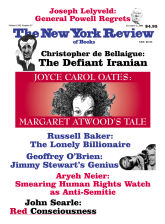In response to:
The Titan of Titans from the April 27, 2006 issue
To the Editors:
In an otherwise appreciative review of my book, Michelangelo and the Reinvention of the Human Body [NYR, April 27], Ingrid Rowland complains that I have seriously underestimated the importance of Etruscan sculpture for the artist. I refer to Etruscan art only once—in relation to the allegorical sculptures in the Medici Chapel—but she dismisses my discussion as “academic,” and plainly believes there is much more to say on this matter. Etruscan sources and contexts are invoked throughout her review, as though they were a lost key to Michelangelo’s art. Indeed, she believes he was entranced by its “crazy charm” (not a quality that one readily associates with Michelangelo) as well as by its local “Tuscan” origin. To clinch her argument she writes: “Michelangelo knew [Etruscan sculptures] well; Casa Buonarroti is full of them.”
As far as I know, the only reason why Casa Buonarroti has any Etruscan art is because Michelangelo’s heirs collected it. His great-great-nephew, the antiquarian Filippo Buonarroti (1661–1733), is the most obvious source and inspiration as he edited De Etruria Regalia (eight volumes, 1723), a classic study of Etruscan art written a century earlier by Thomas Dempster, a Scottish scholar based in Pisa. Buonarroti provided some of the illustrations and in the following year published a commentary on it. In the catalog to the 1986 exhibition in Casa Buonarroti, Filippo Buonarroti e la cultura antiquaria sotto gli ultimi Medici, Daniela Gallo assumes he must have collected most of the Etruscan art in the collection.
He is best known, however, for his pioneering Osservazioni sopra alcuni frammenti di vasi antichi di vetro ornate di figure trovati nei cimiteri di Roma (1716), in which he made the then-revolutionary claim that the aesthetic crudity of early Christian art—often made by amateur artists—served to intensify the piety of the worshiper. Filippo Buonarroti thus helped pave the way for the appreciation of so-called primitive art: Rowland’s own appreciation for Etruscan art is ultimately informed by it. While Michelangelo was evidently interested in Etruscan art, the “Tuscan” art that most excited him—apart from that of Masaccio and Donatello—was medieval.
Rowland is also misleading when she says that Michelangelo’s drawings for Vittoria Colonna are characterized by “woolly execution,” and that the “decisive line that distinguishes Michelangelo’s earlier drawings survives only in his designs for architecture.” The crucifixion drawing made for Colonna in the British Museum is arguably the most “decisive” he ever made, with the lines of the cross carefully ruled, and Christ’s anatomy painstakingly delineated. The level of detail of the central motif is intensified by the contrast with the weeping angels, flanking the cross, which are only sketched in. Colonna’s taste was evidently for miniaturist precision: the badly abraded Pietà in Boston, which was also made for Colonna, would originally have had a very similar appearance. Rowland quotes from the first part of her letter of thanks for this drawing in which she says that it “has certainly crucified in my memory every other picture I have ever seen.” But then Colonna continues: “Nor could one see another better made, more lifelike or more finished; and for sure I could never explain how subtly and wonderfully it is made. I have looked at it closely in [a strong] light and through a magnifying glass and in a mirror and I never saw anything so well finished.” The crucifixion drawing “crucifies” every other drawing because it is as sharp as a nail. The “woolly” crucifixion drawings date from long after Colonna’s death in 1547. Perhaps Rowland has been misled by the illustration in the British Museum catalog, where it is muddily reproduced at a ninth of its actual area (12 x 9 cm instead of 37 x 27 cm).
James Hall
London, England
Ingrid Rowland replies:
The fact that most of the Etruscan artifacts in Casa Buonarroti are ultimately traceable to Filippo does not exclude the possibility that some of them, including in particular that category known to scholars as “Etrusco-Roman bronzes,” may have been collected by Michelangelo. I am not in the least misled in my remarks about Michelangelo’s Crucifixion for Vittoria Colonna, nor about the identity of the drawing to which I directed my judgment of “woolly” after repeated scrutiny of the original in search of the right adjective; would it not be more sober to say that tastes differ? Let me reiterate to Mr. Hall, lest the point be lost, that I greatly enjoyed reading his book.
This Issue
November 2, 2006



